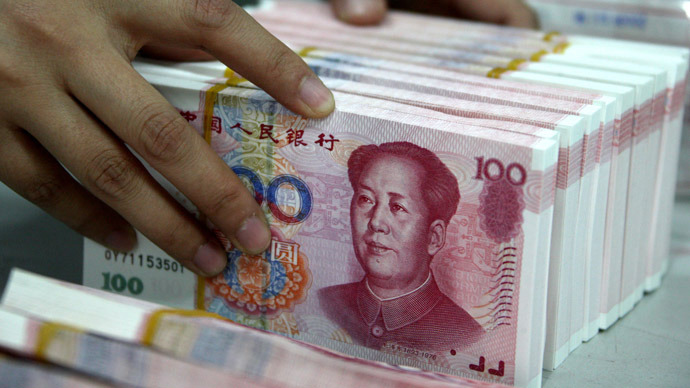The People's Bank of China poured 300 billion yuan ($ 46 billion) in the country's financial system through the reverse repo mechanism on Monday.
This is the largest daily liquidity injection since January 18. Then the Central Bank sharply increased the money injections before the celebration of the Lunar New Year.
October 1 is a national holiday in the People's Republic of China, and on this occasion the financial markets of the country will be closed the first week of the month.
Demand for cash, as a rule, significantly increases before the October holidays. This year, as expected, the seasonal liquidity squeeze will be more significant, as the maturity of freely circulating certificates of deposit for a record amount of 2.3 trillion yuan is expiring this month. The People's Bank of China usually increases the money supply on the eve of the week-long holidays.
"Increasing injections will help to maintain stability at this stage," said an analyst at Shenwan Hongyuan Group Co. in Shanghai. "It was expected that the People's Bank of China would increase cash injections, given the demand before the end of the quarter, long holidays and maturities of freely negotiable certificates of deposit ".
According to weighted average prices, the interbank rate on 7-day REPO transactions as of 10:44 in Shanghai decreased by 12 basis points to 2.78%.
The yield of 10-year government bonds increased by 1 b. to 3.62%.
Earlier, the Chinese State Research Center said that public debt is not so risky.
Scientists from the Chinese Academy of Social Sciences (CASS) have analyzed the state budget for several years and came to the conclusion that a large volume of state assets can compensate for debt risks.
According to CASS calculations, state assets in 2015 amounted to about 125.4 trillion yuan ($ 19 trillion), which is about 1.8 times more than GDP. Assets include fixed assets such as buildings and cars, resources such as land and oil deposits, and cash on state deposits, in social security funds and financial institutions.
However, these assets are not highly liquid, and researchers are warning of implicit dangers. They point to the so-called hidden debt, or obligations, which have a hidden state guarantee.
This includes the issuance of bonds by quasi-governmental organizations, the debt of the state operator of railways, the obligations of local government, the non-repayable loans of state financial institutions, the hidden external debt and the potential deficit of the country's pension fund.
"The Chinese government has many resources available for use, and it has great stability and flexibility to prevent risks," the researchers wrote. They estimated that the ratio of net state assets to GDP exceeds 80%, which provides reliable protection against financial instability.
source: bloomberg.com, economist.com
This is the largest daily liquidity injection since January 18. Then the Central Bank sharply increased the money injections before the celebration of the Lunar New Year.
October 1 is a national holiday in the People's Republic of China, and on this occasion the financial markets of the country will be closed the first week of the month.
Demand for cash, as a rule, significantly increases before the October holidays. This year, as expected, the seasonal liquidity squeeze will be more significant, as the maturity of freely circulating certificates of deposit for a record amount of 2.3 trillion yuan is expiring this month. The People's Bank of China usually increases the money supply on the eve of the week-long holidays.
"Increasing injections will help to maintain stability at this stage," said an analyst at Shenwan Hongyuan Group Co. in Shanghai. "It was expected that the People's Bank of China would increase cash injections, given the demand before the end of the quarter, long holidays and maturities of freely negotiable certificates of deposit ".
According to weighted average prices, the interbank rate on 7-day REPO transactions as of 10:44 in Shanghai decreased by 12 basis points to 2.78%.
The yield of 10-year government bonds increased by 1 b. to 3.62%.
Earlier, the Chinese State Research Center said that public debt is not so risky.
Scientists from the Chinese Academy of Social Sciences (CASS) have analyzed the state budget for several years and came to the conclusion that a large volume of state assets can compensate for debt risks.
According to CASS calculations, state assets in 2015 amounted to about 125.4 trillion yuan ($ 19 trillion), which is about 1.8 times more than GDP. Assets include fixed assets such as buildings and cars, resources such as land and oil deposits, and cash on state deposits, in social security funds and financial institutions.
However, these assets are not highly liquid, and researchers are warning of implicit dangers. They point to the so-called hidden debt, or obligations, which have a hidden state guarantee.
This includes the issuance of bonds by quasi-governmental organizations, the debt of the state operator of railways, the obligations of local government, the non-repayable loans of state financial institutions, the hidden external debt and the potential deficit of the country's pension fund.
"The Chinese government has many resources available for use, and it has great stability and flexibility to prevent risks," the researchers wrote. They estimated that the ratio of net state assets to GDP exceeds 80%, which provides reliable protection against financial instability.
source: bloomberg.com, economist.com





